Experiencing sustainability education through place: A case-study from rural-regional Australia
Keywords: place, environmental education, case-study, primary school
Introduction
David Orr (1992, p.90) claimed in his seminal book, Ecological Literacy, “all education is environmental education”. By locating all educational experiences as occurring in and through the environment – the places – in which we live, Orr was emphasising the importance of place in our educational experience. Many across a number of fields, including, but not limited to, philosophy, geography, humanities, and education, have highlighted the value of drawing on place as central to understanding the world that we live in. When we speak of place, we rarely stop to consider what ‘place’ may mean. Gruenewald (2006, p. 4) claims that “to know anything about the world is to know its places”, and yet place is “one of the most multilayered and multipurpose keywords in our language” (Harvey, 1993, p. 208). It is through concepts of place and space that we seek to understand and locate ourselves in the world. Further, wherever we are and whatever we are learning we are always in place and these places matter. Through the places we cohabit, move, live in, and experience we generate understandings of our world. We cannot escape place.
In recognition that education is invariably situated in the places that it is practised, there are a growing number of educators advocating place-conscious or place-based education. Place-based education has connotations of being about the locality, while place-consciousness fosters an understanding of the interrelatedness between places and suggests a consciousness of both one’s immediate place as well as “an awareness of other places beyond one’s own local environment” (Gruenewald, 2005, p. 263). As Arenas (1999, p. 2) maintains, without a pedagogy of place “children cannot comprehend, even less feel a sense of commitment towards, [environmental] issues and problems in distant places until they have a well-grounded knowledge of their own place”. Furthermore, Sobel asks, “What really happens when we lay the weight of the world’s environmental problems on eight and nine year olds already haunted with too many concerns and not enough real contact with nature?” He goes on to claim that “what is important is that children have an opportunity to bond with the natural world, to learn to love it and feel comfortable in it, before being asked to heal its wounds” (Sobel, 1996, p. 9-10). Embracing place as central to our understanding and experience of the “purpose, process and structure of schooling” (Gruenewald, 2005, p. 263), encompasses a hope by educators to connect classrooms and communities by:
… ‘tear[ing] down’ school walls so that the community becomes integral to all facets of student learning – that is, that the school is open and inviting to the community and the community welcomes student learning occurring in many dimensions (Powers, 2004, p. 18).
Within education, the aim of becoming conscious of places is to make learning more relevant to “the lived experiences of students and teachers … so that places matter to educators, students and citizens in tangible ways” (Gruenewald, 2003, p. 620). As Powers (2004, p. 18) argues, education that is conscious of and uses place allows students to “see the relevance of what they are learning and therefore become more engaged in the learning process”. The importance of recognising the role of people as place-makers suggests that schools could take a “more active role … in the study, care and creation of places” (Gruenewald, 2003, p. 627). Moreover, through taking a more active role in the ‘study, care and creation’ of places, students and teachers can begin to reflect on how “places, and our ideas about them, became what they are”. This allows students to take part in the process of shaping – and therefore being shaped by – what their places will become (Gruenewald, 2003, p. 627).
The connection between classrooms and communities can be particularly important in rural and regional areas of Australia often positioned as being in deficit. Contributing issues to rural-regional educational disadvantage include isolation, small school populations, long distances to major cities and capitals, and a lack of access to educational opportunities (Squires, 2003). Education that is conscious of place within small rural and regional schools benefits from access to strong community networks, large school grounds or close access to land, as well as multi-skilled and cross-generational community members willing to share skills and local knowledge.
There are several examples in rural-regional Australia where schools, along with their communities, have turned to place and sustainability as a central curriculum theme. These examples have often shown how struggling, rural, communities were revitalised by connections between classrooms and those in the community through grounding educational experiences in the places students live (Comber, Nixon, & Reid, 2007; Somerville, 2012; Somerville & M. Green, 2011). A larger multi-case doctoral research study that analysed and theorised place, practice, and knowledge in environmental education provides the context within which the case-study discussed in this article was undertaken. The discussion in this article provides a description of one small, rural primary school in south-east Australia as it worked with the community to regenerate a degraded community space through fostering both environmental and rural-regional sustainability.
Methodology
The exploration of the everyday actions and interactions that informed the practices of environmental and sustainability education in an Australian primary school was the focus of the research project through which the case-study was constructed. Case-study methodology allowed for a focus on the “concrete, practical, and context-dependent knowledge” of real-life situations and practices. In turn, this provided a methodological basis through which to generate an account of environmental education practice in those schools (Flyvbjerg, 2001, p. 70). The context provided through a close exploration of case-study enabled a deep understanding of place and environmental education practice in the school as well as an opportunity to explore practice differently, given that “human behaviour cannot be meaningfully understood as simply … rule-governed acts” (Flyvbjerg, 2001, p. 72).
Case-study methodology allowed an emphasis on the contextualised knowledge and experiences of environmental and sustainability education in the primary schools. This allowed for the observation of social and individual actions and practices in those places, the development of a historically contextualised understanding of that place, and the inclusion of multiple participant perspectives and sources in generating data (Flyvbjerg, 2001; Stark & Torrance, 2005). The generation and analysis of qualitative data involved the use of multiple sources of evidence including interviews with teachers, students, and community members, the collection of documents and photographs, and observation of both formal class lessons and informal play of students during recess and lunch times. This contributed to the procurement of a large amount of data that allowed for richly built case-studies (Gillham, 2000).
The context of the broader research project focused on the case-study schools’ engagement in place in order to explore and theorise place, knowledge, and practice in environmental and sustainability education. However, the discussion in this article centres on the story of Flatlands in order to provide an example of environmental and sustainability education in practice where school and community worked together to regenerate biodiversity and create a sustainable community reserve which emphasised education. In this sense, the community has played a role in shaping place, and the place has shaped the community – providing hope, identity, and uniqueness during a decade-long drought that severely affected many rural communities in southeast Australia. Situated within this partnership between school and community, and fostered through place-based experiences of education, was the realisation of rural-regional and environmental sustainability.
Case-study: An introduction to Flatlands, New South Wales
The township of Flatlands, in the Riverina region of southern New South Wales, has a population of approximately 150 people, and a public school1 (K-6) population of 33 students, drawn from both the town and outlying farms. A twenty minute drive from a nearby regional centre, some of the town’s population commutes to work in the city, with many working locally as farm labourers and tradespeople. Much of the nearby rural landscape is broad-acre crop farming, although there has been an increase in numbers of hobby farms over the past two decades. Local groups, particularly Landcare2, have put much effort into increasing local biodiversity and native habitat through educating the farming community, establishing wildlife corridors and conducting audits and seed banks of remnant native vegetation.
Flatlands Public School was located on a side road off the main road through the town. The school consisted of five buildings: two classrooms housing the Primary (Years 3-6) and Infants (Years K-2) classes; the library/staff room; the weather shed; and, the toilet block. Daniel, the principal, and two classroom teachers are the teaching staff in the school, with the addition of a gardening teacher, Julia, who works one day a week with small groups of students, and, Emily a teacher’s aide and environmental scientist who works one day a week at the school. In his role as principal, Daniel takes classroom release for Miranda (K-2) and Colleen (3-6), as well as facilitating the 2000 or more students that visit the school’s adjacent Environmental Education Centre every year. Within the school’s curriculum, Miranda and Colleen take responsibility for the ‘literacy’ (English KLA) and ‘numeracy’ (Mathematics KLA) lessons, with Daniel teaching the classes for science, social studies and physical education, and creative arts and ICT taught by two specialist teachers who visit the school on a fortnightly rotation.
The school grounds were extensive given the number of students. Areas of the grounds were set aside for a bird garden (image 1) with native shrubs and trees to encourage indigenous bird species, a vegetable garden (image 2) used by the infants class, and an area used for making cubbies amongst the pine trees in the ‘school woodlot’. In addition, there were garden beds around each of the buildings (image 3) and a small orchard behind the primary classroom. There was a large concreted area, where students lined up for notices at the beginning of each day, ate morning tea and lunch, played handball and soccer amongst other school yard games, and used for physical education activities. At the front of the school grounds was the infants’ playground.
Adjacent to the school was an Environmental Education Centre and town nature reserve. School and community partnerships saw the regeneration of this four-hectare block of land from a degraded and disused stock reserve3 and public watering place to extensive use in environmental learning by the school, community, and visiting schools in the region.
The development of Flatlands Environmental Education Centre
The development of this space into a nature reserve began in 1993, when three Flatlands locals had a conversation about the old stock reserve adjacent to the public school. Degraded, full of weeds and various rubbish, Susan, a local resident, described it as being “just a bare ugly spot with sheep in it to keep the weeds down!” (Susan, Environmental Education Centre (EEC) committee, FPS, March, 2008). Thinking that it could be turned into “a nice place for the locals to wander around” (John, EEC committee president, FPS, March 2008), they initially considered it being a Bushland Reserve, then an Arboretum. In 1994, the three locals made contact with the local Landcare group, who subsequently expressed considerable interest in the idea. Landcare president at the time, Susan, saw this as an opportunity to highlight plants to local farmers and landowners in order to combat a loss of biodiversity, habitat, and land clearing, and to conserve wildlife in the region. She applied for and received a $600 grant for a landscape plan. Work on the park began in 1995, followed by a decision at the end of that year to invite the school, located next door to the park, to run a contest to name the park. By the end of 1995, the recreation committee in charge of overseeing the park held a meeting and decided that a major focus of the park should be environmental education.
After arranging with the local council to change the designation of the area from stock reserve to recreation ground, the Landcare group invited the school to take an active part in the regeneration of the block in 1996. The principal, Daniel, jumped at the chance and students from the school were involved in planning, propagating, and revegetating land. In 1998, the council redesignated the park as a nature reserve and henceforth a volunteer committee consisting of community and school members has run it. Thus began a partnership between school, community, and local government that saw the co-creation of a place of bio-diversity, regeneration and environmental education, fostering both ecological and rural-regional sustainability (Green & Reid, 2004). As John claimed:
The nature reserve is not just meant for school children; that’s part of the big picture – we like to engage anyone that’s got an interest in the environment and not just Landcare, but just the general public. It’s been great for the community; it’s given them a sense of pride (John, EEC committee president, FPS, March 2008).
Also in 1998, the school agreed to take part in a trial of the Learnscapes4 program and procured some funding from the NSW Department of Education and Training. Involvement in Learnscapes had the students planning, propagating, and planting in the nature reserve. The following year the school and nature reserve won the New South Wales Landcare Education Award following nomination by the local Landcare group. Then in 2000, the school and Environmental Education Centre won the National Landcare Education Award, an award that helped to promote the highly regarded work of the school and its work in environmental education. These awards resulted in widespread community and regional recognition, as well as community pride and further engagement in sustainability issues and environmental regeneration.
Since then, the school and Environmental Education Centre have grown and developed, being successful with numerous funding grants and trust applications. Community working-bees contributed to the continuing development of the nature reserve, which included the creation of three wetland ponds in addition to the already present dam, building a composting toilet and a rammed earth building for the Discovery and Learning Centre, and creating an endemic seed bank. In addition, the nature reserve became a stage for community events, ranging from National Wattle Day5, to church services and weddings. Finally, the Environmental Education Centre became a model for other communities, schools, and environmental organisations in the region through its involvement in the Learnscapes program, the Australian Sustainable Schools initiative (AuSSI) 6, and Junior Landcare. As John, the committee president, wrote in a history about the development of the nature reserve and Environmental Education Centre in 2006:
… the challenge is to make a ‘real difference’ in the world of Environmental Education and to be a model of ‘best practice’ in the teaching of future generations of young Australians ([Flatlands] Environmental Education Centre: A place of Discovery and Learning – The [Centre’s] Story, document collected at FPS, March, 2008).
Teaching-learning place and environment in the case-study
The Flatlands Public School has adopted an integrated, whole-school approach to teaching and learning in environmental and sustainability education. The students were involved in day-to-day activities that emphasised the place and environment of the school and community. I explore here some of the key aspects of my observations at this school, which I felt contributed to its uniqueness and its distinctive approach to environmental learning, including the opportunities provided to students, and for students, for informal learning. I provide a brief overview of this as a context for the school.
Learnscapes at Flatlands Public School
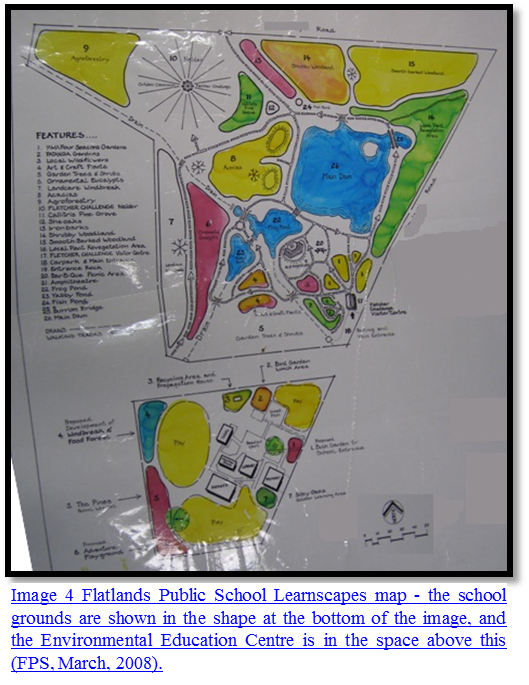 Nearly concurrent to the development of the Environmental Education Centre and nature reserve, was the school’s involvement in the trial of the Learnscapes program in New South Wales. As part of the Learnscapes trial, Daniel realised that the actual Learnscapes did not need to be contained within the school grounds, providing impetus for school-community collaboration:
Nearly concurrent to the development of the Environmental Education Centre and nature reserve, was the school’s involvement in the trial of the Learnscapes program in New South Wales. As part of the Learnscapes trial, Daniel realised that the actual Learnscapes did not need to be contained within the school grounds, providing impetus for school-community collaboration:
That’s when my eyes lit up and I saw that and I thought, ‘oh well, this is all right!’ So I was approached to get involved from the Department [of Education] in Sydney. And we were given a bit of a carrot, a couple of thousand dollars I think, to help to try and develop some plans and do some workshops and it sort of grew from that. So our Learnscape is actually probably more outside the school than inside the school (Daniel, principal, FPS, March, 2008, image 4).
The tearing-down of the old school fence, replaced by a low mesh fence, signified the connectedness between the school and the nature reserve as part of the Learnscapes process.
Daniel considered that the school’s involvement in both projects was an example of good timing. Further impetus came when they won state and national awards early in the environmental education centre’s development, lending it credibility, respect, and – most importantly – support within the community. John and Susan, from the Environmental Education Committee, believed that what started as an idea with locally focused, informal educative goals, turned into something much more than anyone could have imagined.
There used to be a teachers’ residence between here and halfway between here and the centre. Now, the residence wasn’t here when I came, but the legacy of it was. There was a tin fence right across down there and a tin fence behind and a garage was still there. Well as part of the Learnscape philosophy … my vision was that this wouldn’t work unless it was all one site. If you had to walk across the road and that was seen as, you know, ‘that was Flatlands EEC and this was the school’, it wasn’t going to work. The first thing we did was we ripped down the fences and we sold the garage, cleaned the place up and put a gate… put a nice little low fence and a track across and we claimed it and said that ‘this was part of the school grounds’. As far as the community knows, that is part of the school grounds. Technically, on paper, it’s owned by the council and we’ve got a hundred year lease on it. But for all intents and purposes, people who visit, people who come, they see that as one – that’s part of our school grounds. So, we’ve adopted it. And that’s been a critical thing. Even though we don’t fully manage it, we’ve still got a … it’s just all blurred together (Daniel, principal, FPS, March, 2008, image 5).
Informal student learning: Conversations, cubbies7 and gardening class
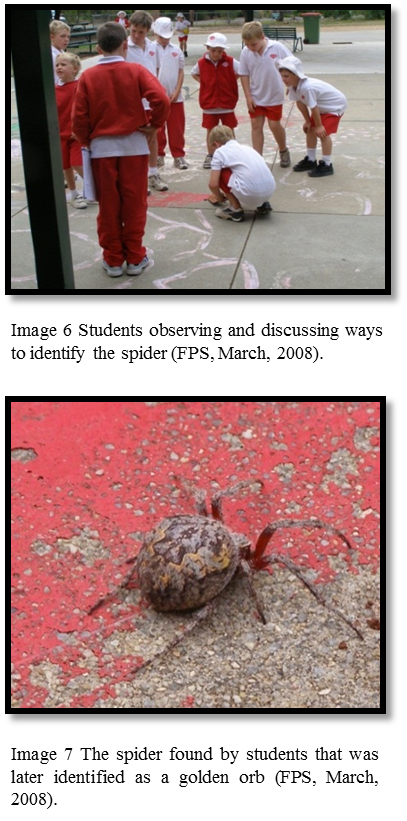 Students at Flatlands Public School had many opportunities for informal environmental and place-conscious learning. Three things, in particular, highlighted the opportunities of students to informal environmental learning.
Students at Flatlands Public School had many opportunities for informal environmental and place-conscious learning. Three things, in particular, highlighted the opportunities of students to informal environmental learning.
In the first instance, due to the small size of the school and the personable, friendly, and charismatic nature of the teaching staff, students were often involved in conversations with teachers and each other about the natural world. An example observed during one recess break was when students found a large, spider that they brought to the teachers (image 6 and 7). Following a discussion on how to identify the spider, the students who found it carefully returned the spider and left it undisturbed, as well as other insects or animals that they came across.
This approach to dealing with student curiosity meant that students were encouraged to be inquisitive and follow their interests, as well as provided with support in developing their curiosity. It also meant that they were encouraged to take risks through being inquisitive, as well as learning how to find answers to their questions. I observed the same attitude and approach several times during my visit to the school, demonstrated through Daniel’s comment:
… kids are bringing me in things all the time to observe. You know, they’ll bring things in jars, they’ll bring in leaves, they’ll bring in an insect or a spider or a dead snake. They’re always bringing things in and showing and talking … So things, like incidental things like that’s happening … I feel it’s just got to be a part of their everyday life that they’re doing (Daniel, principal, FPS, March, 2008).
Miranda also commented on this as setting the school apart:
I think that the environmental focus in this school and the fact that Daniel is really motivated in that direction really motivates the children in that direction too … I think that it has just made the children a lot more environmentally aware than they would have been just being brought up in a normal school with the tar and the cement and neatly cut lawns and all of the rest of it that you associate with normal schools. I really think that the children get a broader interest and a more natural interest; it just happens, it is just a part of the way that they think and, which is a huge benefit to them which helps them in the long run, makes them more observant, makes them more aware of what’s going on around them (Miranda, Yr. 3-6 teacher, FPS, April, 2008).
Students had many opportunities for informal learning through play and risk taking. The building of cubbies in the garden areas of the school grounds was encouraged by teachers. In addition to this, the teachers took a “hands off” (Miranda, Yr. 3-6 teacher, FPS, April, 2008) attitude toward student cubby making unless there were safety concerns.
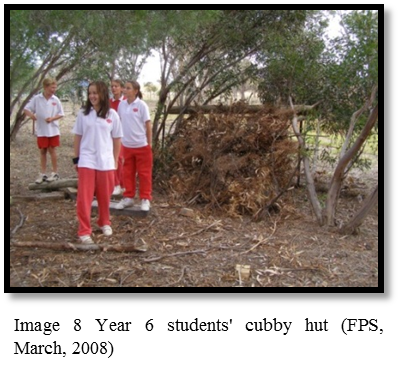 As a result, every student in the school was involved to some degree in cubby making (image 8). Lunchtime and recess observation of play showed the students engaged in diverse fantasy worlds through their cubby-making and play. Further, the discussion of cubbies was also present in the older students’ interviews, with each of the participating Year 6 students taking photos of their various cubby spots and talking about them during interviews. Again, the informal play and learning opportunities from participating in these play-based activities were an invaluable part of the experience of students at this school, and of their learning to relate to the natural environment.
As a result, every student in the school was involved to some degree in cubby making (image 8). Lunchtime and recess observation of play showed the students engaged in diverse fantasy worlds through their cubby-making and play. Further, the discussion of cubbies was also present in the older students’ interviews, with each of the participating Year 6 students taking photos of their various cubby spots and talking about them during interviews. Again, the informal play and learning opportunities from participating in these play-based activities were an invaluable part of the experience of students at this school, and of their learning to relate to the natural environment.
A third example of informal learning opportunities of students at Flatlands Public School involved the dedication of class time to gardening. In developing a maintenance budget, Daniel had reallocated some of the maintenance funding for grounds keeping, to pay a local parent, Julia, for three hours each week as a gardening teacher. As Daniel stated, “we have made that a priority in our school community – that our children are going to get that experience every week. That is going to be one of the things: that they are going to be out there, hands on” (Daniel, Principal, FPS, March, 2008).
In Stage groups8, students spent an hour or so with Julia every week undertaking a range of activities from weeding, irrigation, planting, propagating, composting, and watering, in both the vegetable garden as well as the more extensive Environmental Education Centre gardens.
While undertaking this activity, the conversation of the students revolved around the weeds they were pulling up, the plants that they were not pulling up, the insects, bugs and worms that they saw, and general chatter about events in their lives – sports, family visits, and weekend activities. These classes were valuable, both for the practices modelled to students, as well as the conversations and the informal nature and minimal structure of the class. In particular, Julia said that:
I love my children touching earth, because they don’t get enough of it … I just make sure that, you know, they are in touch with what is going on around them, because there is so many structured things, like everybody takes their kids to swimming and cricket and football training and we do that too … but it is all structured, so they are in the classroom all day and then after school they go to this structured lesson again. I like the idea of bringing the kids out and you know they get to weed and they get to mulch and they just love it (Julia, gardening teacher, FPS, March, 2008).
The Flatlands Environmental Education Centre
ReThe principal, Daniel, was a driving force behind the environmental education focus at the school and was very active in sourcing funding for the school and the Environmental Education Centre. Environmental education had become an important priority for the school community, and something that Daniel felt was fundamental to his own role, particularly in “…the need for encouraging kids to take risks and get outside and get their hands dirty… challenge them, you know” (Daniel, principal, FPS, March, 2008). Daniel approached the task of establishing environmental education as central to the work of the school and worked to ensure that students had access to many outdoor, sustainable, and place-based experiences. To Daniel, environmental education was a curriculum area addressed through everyday schooling, rather than separately or in a specific, fixed manner:
… it’s not something that you can really write down and say this is the formula. We sort of are very flexible, open approach to … connecting with whatever needs connecting with, then and there. (Daniel, principal, FPS, March, 2008)
The school and Environmental Education Centre had gained quite a lot of recognition for their environmental education work, both with the local community as well as with schools in the region. Daniel’s work in advocating environmental education and promoting the school-fostered partnerships with environmental education networks in the United Kingdom and Scandinavia. He participated in a study tour to those countries in 2005, in turn hosting representatives from those networks at the school. In addition to this, Daniel has worked on developing a local environmental education network with schools in the region, and together they have adapted a state-wide unit of work for their local context, alongside the production of a six-part DVD series and workbook to support the unit of work.
Through the development of the Environmental Education Centre, schools in the local region have had access to educational experiences in native bushland being regenerated with local plant species, as well as learning about conservation of habitat and species for biodiversity. The nature reserve, from an ecological perspective, had provided habitat for the endangered sugar-glider possums, and a stopover point for migrating red-king parrots. Audits undertaken of bird species in the immediate area had seen an increase from 50 bird species in the late 1990s, to over 130 bird species by early 2008.
Although Daniel championed the integration between the Environmental Education Centre and the curriculum and decision-making in the school, due to the nature and size of the school it was clear that the teachers worked well together to support this focus. Neither Miranda or Colleen felt that they were responsible for taking “the environmental side” (Miranda, Yr. K-2 teacher, FPS, April, 2008), yet, at the same time, there was evidence in lessons, discussions, interviews, and student work samples of these teachers also drawing on various environmental themes in their teaching practice. In addition, both Miranda and Colleen expressed that while they felt the Environmental Education Centre was a useful, if not so frequently used curriculum resource, for them, the school grounds provided them with more scope as a resource that they could integrate with other aspects of their teaching:
I don’t deliberately set out to teach environmental issues or environmental content, mine just kind of happens along the way; I see [the school grounds] as a resource and I use it for a particular idea that I want to present or a particular text type I want to develop (Miranda, Yr. K-2 teacher, FPS, April, 2008).
Conclusion
The discussion of the case study provided only covers a snapshot of the environmental and sustainability education practices at Flatlands Public School. However, it does provide an understanding of the valuable partnership between school and community in creating place for environmental learning. The development of the environmental education centre involved a range and variety of interconnecting and interrelated practices of place, curriculum, and sustainability and environmental education. Central to this discussion of place-based education, was the school’s focus on sustainability and environment where there was connection with the community and community resources. The size of the school and community, and the school’s access and contribution to the ongoing development of the Environmental Education Centre, meant that for these students environment and sustainability experienced through local place was a significant part of their everyday schooling. The staff participating in this research were aware of the uniqueness of their school, and conveyed a sense of place and a pride in what they enabled students to experience. There was a focus on developing students’ biodiversity and environmental science-based understandings, with sustainability education providing a background theme integrated across the practices of the school. Finally, despite the teachers having beliefs about whether or not they did environmental and sustainability education, it did form a background to much of the students’ experience of schooling, evident throughout the interviews, conversations, and observations of students and staff.
Places define who we are and what we do. By centring the ways that we care for and live sustainably in place, rural and regional communities are in a position to develop their sense of identity and pride in their community. As evidenced through this case-study, one way of promoting rural-regional sustainability is by fostering the use, regeneration and sustaining of natural places within communities. Through focusing on the places where they live and experience the world, schools and communities provide opportunities that encourage regenerative and sustainable living not just to the students, but the wider community. Where this happens, experiences of education that foster a consciousness of place are central to environmental and sustainability education practice.
Reference list
Arenas, A. (1999, April). If we all go global, what happens to the local? In defense of a pedagogy of place. Paper presented at the Annual Meeting of the Comparative and International Education Society, Toronto, Canada.
Bowers, C. A. (2004). Revitalizing the commons or an individualized approach to planetary citizenship: The choice before us. Educational Studies, 36(1), 45-58.
Comber, B., Nixon, H., & Reid, J.-A. (2007). Literacies in place: Teaching environmental communications. Newtown, N.S.W.: Primary English Teaching Association.
Flyvbjerg, B. (2001). Making social science matter. Cambridge, U.K.: Cambridge University Press.
Gillham, B. (2000). Case study research methods. London and New York: Continuum.
Green, B., & Reid, J.-A. (2004). Teacher education for rural-regional sustainability: Changing agendas, challenging futures, chasing chimeras? Asia-Pacific Journal of Teacher Education, 32(3), 254-273.
Gruenewald, D. A. (2003). Foundations of place: A multidisciplinary framework for place-conscious education. American Education Research, 40(3), 619-654.
Gruenewald, D. A. (2005). Accountability and collaboration: Institutional barriers and strategic pathways for place-based education. Ethics, Place & Environment, 8(3), 261-283.
Gruenewald, D. A. (2006, April). Why place matters: The everyday context everywhere of experience, culture, and education. Paper presented at the meeting of the Association of Educational Research in America, San Francisco.
Harvey, D. (1993). From space to place and back again: Reflection on the condition of postmodernity. In J. Bird (Ed.). Mapping the futures: Local cultures, global change (pp. 2-29). London: Routledge.
Orr, D. (1992). Ecological literacy: Education and the transition to a postmodern world. Albany, NY: University of New York Press.
Powers, A. L. (2004). An evaluation of four place-based education programs. Journal of Environmental Education, 35(4), 17-32.
Sobel, D. (1996). Beyond ecophobia: Reclaiming the heart in nature education. Great Barrington, M.A.: The Orion Society.
Somerville, M. (2012, December). Place, literacy and sustainability: Emerging transformations in theory and practice. Paper presented at the meeting of the Australian Association for Research in Education, Sydney.
Somerville, M., & Green, M. (2011). A pedagogy of “organized chaos”: Ecological learning in primary schools. Children, Youth & Environments, 21(1), 14-34.
Squires, D. (2003). Responding to isolation and educational disadvantage. Education in Rural Australia, 13(1), 24-40.
Stark, S., & Torrance, H. (2005). Case Study. In B. Somekh & C. Lewin (Eds.). Research methods in the social sciences (pp.33-40). London: Sage.
Tunggal, H. T. (2008). Learnscapes planning and design. Retrieved from http://www.learnscapes.org/
Endnotes
1 In New South Wales, Australia, public schools are the state government owned and operated schools.
2 Landcare is an Australian movement that involves individuals and groups working together under the ethic of caring for the land. While Landcare’s initial focus was on improving agricultural productivity through sustainable land management, it has since evolved to have a broader focus on the sustainable management of Australian natural resources and includes groups and individuals working across coastal, rural, urban and remote areas of Australia. For further information, see http://www.landcareonline.com.au
3 A stock reserve is a pasture reserved for use by travelling livestock, particularly useful in times of drought when drovers will move livestock to seek better feed conditions. Where they exist, stock reserves are public land maintained by state governments.
4 Learnscapes Planning and Design is an organisation that works with schools to create experiential learning environments, typically in the school grounds although they can also be developed outside of the school grounds. The aim of this program is to “enhance student’s learning through active participation” and “create new outdoor spaces where students can learn and play more effectively and enjoyably” (Tunggal, 2008, para. 4). I refer to this program in this article as Learnscapes. For further information, see http://www.Learnscapes.org
5 National Wattle Day signifies the first day of spring in Australia, recognising the flowering of the Golden Wattle (Acacia pycnantha), Australia’s national floral emblem. For further information, see http://www.wattleday.asn.au/
6 The Australian Sustainable Schools Initiative (AuSSI) is an Australian state and federal government initiative that engages schools in a broad framework for incorporating the sustainable management of resources and facilities as a whole-of-school approach. For further information, see http://www.environment.gov.au/education/aussi/
7 Cubby, or cubbies, is an Australian term for children’s self-constructed play spaces – much like the North American term ‘forts’.
8 The NSW education system groups students into year level stages where Early Stage 1 (ES1) refers to the first year of schooling (Kinder, also known as Prep, Reception or Foundation in other states in Australia); Stage 1 (S1) refers to students in Year 1 and 2; Stage 2 (S2) refers to students in Year 3 and 4; and Stage 3 (S3) refers to students in Year 5 and 6.







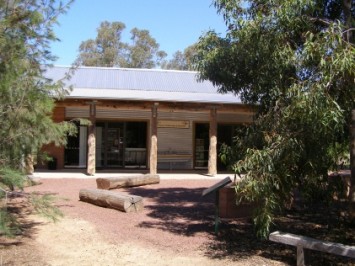
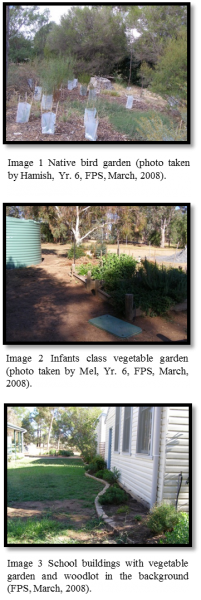
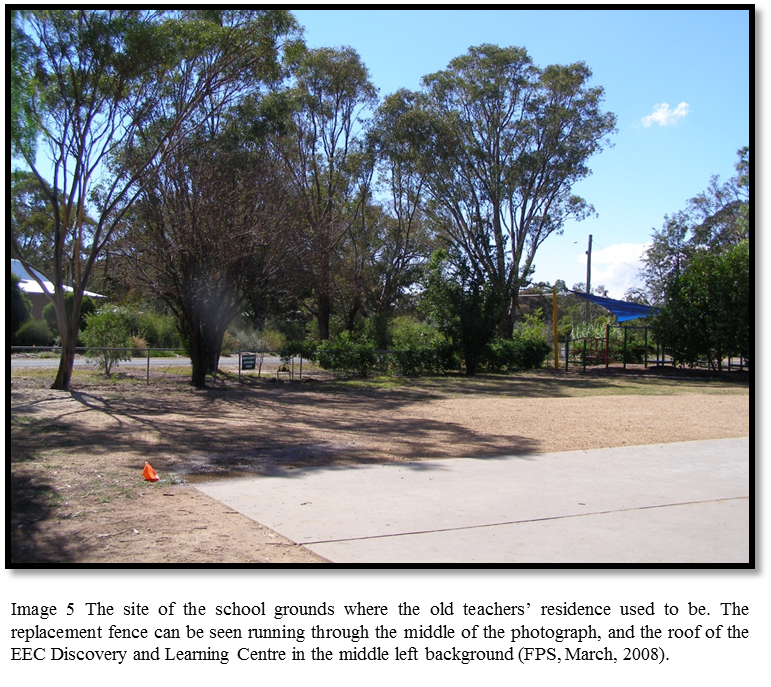



 Rebecca Miles lectures in education at La Trobe University, Albury-Wodonga, Australia. Her doctoral research explored the intersection of place, knowledge, and practice in environmental and sustainability education through case-studies of primary schools. Rebecca can be contacted at r.miles@latrobe.edu.au
Rebecca Miles lectures in education at La Trobe University, Albury-Wodonga, Australia. Her doctoral research explored the intersection of place, knowledge, and practice in environmental and sustainability education through case-studies of primary schools. Rebecca can be contacted at r.miles@latrobe.edu.au 
